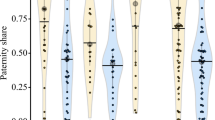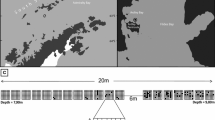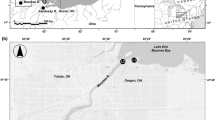Abstract
Salmonids are known for the occurrence in sympatry of two life-history forms, one that undergoes migration to sea before returning to freshwater to reproduce (anadromous) and one that inhabits freshwater without a migration phase (resident). Whereas one breeding population is often suggested by population genetic studies, mating patterns have rarely been directly assessed, especially when both sexes are found within each life-history form. By using highly polymorphic microsatellite loci and parentage analysis in a natural population of sympatric anadromous and resident brook charr (Salvelinus fontinalis), we found that gene flow occurred between the two forms and was mediated by resident males mating with both resident and anadromous females. Determinants of reproductive success, estimated by the number of surviving juveniles (ages 1 and 2 years), differed between the sexes. No strong evidence of the influence of size on individual reproductive success was found for males, whereas larger females (and hence most likely to be anadromous) were more successful. The higher individual reproductive success of anadromous fish compared to residents was mainly explained by this higher reproductive success of anadromous females. We suggest that resident males adopt a “sneaking” reproductive tactic as a way of increasing their reproductive success by mating with females of all sizes in all habitats. The persistence of the resident tactic among females may be linked to their advantage in accessing spatially constrained spawning areas in small tributary streams unavailable to larger females.





Similar content being viewed by others
References
Avise JC, Jones AG, Walker D, DeWoody JA (2002) Genetic mating system and reproductive natural histories of fishes: lessons for ecology and evolution. Annu Rev Genet 36:19–45
Belkhir K, Borsa P, Chikhi L, Raufaste N, Bonhomme F (2000) GENETIX 4.02, Logiciel sous Windows TM pour la génétique des populations. Laboratoire Génome, Populations, Interactions, CNRS UMR 5000, Université de Montpellier II, Montpellier, France
Belkhir K, Castric V, Bonhomme F (2002) IDENTIX, a software to test for relatedness in a population using permutation methods. Mol Ecol Notes 2:611–614
Blanchfield PJ, Ridgway MS, Wilson CC (2003) Breeding success of male brook trout (Salvelinus fontinalis) in the wild. Mol Ecol 12:2417–2428
Blomqvist D, Andersson M, Kupper C, Cuthill IC, Kis J, Lanctot RB, Sandercock BK, Szekely T, Wallander J, Kempenaers B (2002) Genetic similarity between mates and extra-pair parentage in three species of shorebirds. Nature (Lond) 419:613–615
Bohlin T, Dellefors C, Faremo U (1994) Probability of first sexual maturation of male parr in wild sea-run brown trout (Salmo trutta) depends on condition factor 1 yr in advance. Can J Fish Aquat Sci 51:1920–1926
Boula D, Castric V, Bernatchez L, Audet C (2002) Physiological, endocrine, and genetic bases of anadromy in the brook charr, Salvelinus fontinalis, of the Laval River (Quebec, Canada). Environ Biol Fish 64:229–242
Brookfield JFY (1996) A simple new method for estimating null allele frequency from heterozygote deficiency. Mol Ecol 5:453–455
Castric V, Bernatchez L (2003) The rise and fall of isolation by distance in the anadromous brook charr (Salvelinus fontinalis Mitchill). Genetics 163:983–996
Chapuis MP, Estoup A (2007) Microsatellite null alleles and estimation of population differentiation. Mol Biol Evol 24:621–631
Coltman DW, Bancroft DR, Robertson A, Smith J, Clutton-Brock TH, Pemberton JM (1999) Male reproductive success in a promiscuous mammal: behavioural estimates compared with genetic paternity. Mol Ecol 8:1199–1209
Conrad KF, Johnston PV, Crossman C, Kempenaers B, Robertson RJ, Wheelwright NT, Boag T (2001) High levels of extra-pair paternity in an isolated, low-density, island population of tree swallows (Tachycineta bicolor). Mol Ecol 10:1301–1308
Dakin EE, Avise JC (2004) Microsatellite null alleles in parentage analysis. Heredity 93:504–509
DeHaan PW, Ardren WR (2005) Characterization of 20 highly variable tetranucleotide microsatellite for bull trout (Salvelinus confluentus) and cross amplification in other Salvelinus species. Mol Ecol Notes 5:582–585
DeWoody JA, Avise JC (2001) Genetic perspectives on the natural history of fish mating systems. J Hered 92:167–172
Dickerson BR, Willson MF, Bentzel P, Quinn TP (2004) Size-assortative mating in salmonids: negative evidence for pink salmon in natural conditions. Anim Behav 68:381–385
Dickerson BR, Brinck KW, Willson MF, Bentzen P, Quinn TP (2005) Relative importance of salmon body size and arrival time at breeding grounds to reproductive success. Ecology 86:347–352
Docker MF, Heath DD (2003) Genetic comparison between sympatric anadromous steelhead and freshwater resident rainbow trout in British Columbia, Canada. Conserv Genet 4:227–231
Doucett RR, Power M, Power G, Caron F, Reist JD (1999) Evidence for anadromy in a southern relict population of Arctic charr from North America. J Fish Biol 55:84–93
Duchesne P, Castric T, Bernatchez L (2005) PASOS (parental allocation of singles in open systems): a computer program for individual parental allocation with missing parents. Mol Ecol Notes 5:701–704
Feldheim KA, Gruber SH, Ashley MV (2004) Reconstruction of parental microsatellite genotypes reveals female polyandry and philopatry in the lemon shark, Negaprion brevirostris. Evolution 58:2332–2342
Fleming IA (1996) Reproductive strategies of Atlantic salmon: ecology and evolution. Rev Fish Biol Fish 6:379–416
Fleming IA (1998) Pattern and variability in the breeding system of Atlantic salmon (Salmo salar), with comparisons to other salmonids. Can J Fish Aquat Sci 55:59–76
Fleming IA, Gross MR (1994) Breeding competition in a Pacific salmon (Coho, Oncorhynchus kisutch)—measures of natural and sexual selection. Evolution 48:637–657
Fleming IA, Lamberg A, Jonsson B (1997) Effects of early experience on the reproductive performance of Atlantic salmon. Behav Ecol 8:470–480
Foote CJ (1990) An experimental comparison of male and female spawning territoriality in a Pacific salmon. Behaviour 115:283–314
Foote CJ, Wood CC, Withler RE (1989) Biochemical genetic comparison of sockeye salmon and kokanee, the anadromous and nonanadromous forms of Oncorhynchus nerka. Can J Fish Aquat Sci 46:149–158
Garant D, Dodson JJ, Bernatchez L (2001) A genetic evaluation of mating system and determinants of individual reproductive success in Atlantic salmon (Salmo salar L.). J Hered 92:137–145
Garant D, Dodson JJ, Bernatchez L (2003) Differential reproductive success and heritability of alternative reproductive tactics in wild Atlantic Salmon (Salmo salar L.). Evolution 57:1133–1141
Garant D, Dodson JJ, Bernatchez L (2005) Offspring genetic diversity increases fitness of female Atlantic salmon (Salmo salar). Behav Ecol Sociobiol 57:240–244
Garcia-Vazquez E, Moran P, Martinez JL, Perez J, de Gaudemar B, Beall E (2001) Alternative mating strategies in Atlantic salmon and brown trout. J Hered 92:146–149
Gross MR (1987) Evolution of diadromy in fishes. Am Fish Soc Symp 1:14–25
Hazel W, Smock R, Johnsson MD (1990) A polygenic model for the evolution and maintenance of conditional strategies. Proc Biol Sci 242:181–188
Hendry AP, Day T, Taylor EB (2001) Optimal size and number of propagules: allowance for discrete stages and effects of maternal size on reproductive output and offspring fitness. Am Nat 157:387–407
Hindar K, Jonsson K, Rymon N, Stahl S (1991) Genetic relationships among landlocked, resident, and anadromous brown trout, Salmo trutta L. Heredity 66:83–91
Holtby LB, Healey MC (1986) Selection for adult size in female coho salmon (Oncorhynchus kisutch). Can J Fish Aquat Sci 43:1946–1959
Hughes CR (1998) Integrating molecular techniques with field methods in studies of social behavior: a revolution results. Ecology 79:383–399
Hutchings JA, Jones MEB (1998) Life history variation and growth rate thresholds for maturity in Atlantic salmon, Salmo salar. Can J Fish Aquat Sci 55:22–47
Hutchings JA, Myers RA (1988) Mating success of alternative maturation phenotypes in male Atlantic salmon, Salmo salar. Oecologia (Berl) 75:169–174
Jones MW, Hutchings J (2002) Individual variation in Atlantic salmon fertilization success: implications for effective population size. Ecol Appl 12:184–193
Jones MW, Danzman RG, Clay D (1997) Genetic relationship among populations of wild resident, and wild and hatchery anadromous brook charr. J Fish Biol 51:29–40
Jones AG, Östlund-Nilsson S, Avise JC (1998) A microsatellite assessment of sneaked fertilizations and egg thievery in the fifteenspine stickleback. Evolution 52:848–858
Jonsson B (1985) Life history patterns of freshwater resident and sea-run migrant brown trout in Norway. Trans Am Fish Soc 114:182–194
Jonsson B, Hindar K (1982) Reproductive strategy of dwarf and normal Arctic charr (Salvelinus alpinus) from Vangsvatnet Lake, Western Norway. Can J Fish Aquat Sci 39:1404–1413
Jonsson B, Jonsson N (1993) Partial migration: niche shift versus sexual maturation in fishes. Rev Fish Biol Fish 3:348–365
Kempenaers B, Everding S, Bishop C, Boag P, Robertson RJ (2001) Extra-pair paternity and the reproductive role of male floaters in the tree swallow (Tachycineta bicolor). Behav Ecol Sociobiol 49:251–259
Kristoffersen K, Halvorsen M, Jorgensen L (1994) Influence of parr growth, lake morphology and freshwater parasites on the degree of anadromy in different populations of Arctic charr (Salvelinus alpinus) in northern Norway. Can J Fish Aquat Sci 51:1229–1246
Lenormand S (2003) Évolution de l’anadromie et stratégie de reproduction chez l’omble de fontaine, (Salvelinus fontinalis). PhD thesis. Biologie Université Laval, Québec, 122 pp
Lenormand S, Dodson JJ, Ménard A (2004) Seasonal and ontogenetic patterns in the migration of anadromous brook charr (Salvelinus fontinalis). Can J Fish Aquat Sci 61:54–67
Lukasik P, Radwan J, Tomkins JL (2006) Structural complexity of the environment affects the survival of alternative male reproductive tactics. Evolution 60:399–403
Marshall TC, Slate J, Kruuk LEB, Pemberton JM (1998) Statistical confidence for likelihood-based paternity inference in natural populations. Mol Ecol 7:639–655
Morinville GR, Rasmussen JB (2003) Early juvenile bioenergetic differences between anadromous and resident brook trout (Salvelinus fontinalis). Can J Fish Aquat Sci 60:401–410
Morita K, Takashima Y (1998) Effect of female size on fecundity and egg size in white-spotted charr: comparison between sea-run and resident forms. J Fish Biol 53:1140–1142
Morita K, Yamamoto S, Hoshino N (2000) Extreme life history change of white-spotted charr (Salvelinus leucomaenis) after damming. Can J Fish Aquat Sci 57:1300–1306
Narum SR, Control C, Talbot A, Powee MS (2004) Genetic divergence of sympatric resident and anadromous forms of Oncorhynchus mykiss in the Walla Walla River, USA J Fish Biol 65:471–488
Neff BD (2001) Genetic paternity analysis and breeding success in bluegill sunfish (Lepomis macrochiros). J Hered 92:111–119
Nordeng H (1983) Solution to the ‘Char Problem’ based on Arctic char (Salvelinus alpinus) in Norway. Can J Fish Aquat Sci 40:1372–1387
Olsson IC, Greenberg LA (2004) Partial migration in a landlocked brown trout population. J Fish Biol 65:106–121
Pemberton JM, Slate J, Bancroft DR, Barrett A (1995) Nonamplifying alleles at microsatellite loci: a caution for parentage and population studies. Mol Ecol 4:249–252
Perry GML, King T, Valcourt M, St-Cyr J, Bernatchez L (2005) Isolation and cross amplification of forty-three microsatellites for the brook charr (Salvelinus fontinalis). Mol Ecol Notes 5:346–351
Quinn TP, Foote CJ (1994) The effect of body size and sexual dimorphism on the reproductive behaviour of sockeye salmon, Oncorhynchus nerka. Anim Behav 48:751–761
Raymond M, Rousset F (1995) GENEPOP (version 1.2): population genetics software for exact tests and ecumenicism. J Hered 86:248–249
Reynolds JD (1996) Animal breeding systems. Trends Ecol Evol 11:68–72
Rikardsen AH, Svenning M-A, Klemetsen A (1997) The relationship between anadromy, sex ratio and parr growth of Arctic charr in a lake in north Norway. J Fish Biol 51:447–461
Roff DA (1996) The evolution of threshold traits in animals. Q Rev Biol 71:3–35
Rosenberger AE, Dunham JB (2005) Validation of abundance estimates from mark-recapture and removal techniques for rainbow trout captured by electrofishing in small streams. N Am J Fish Manag 25:1396–1410
Schreiber A, Diefenbach G (2005) Population genetics of the European trout (Salmo trutta L.) migration system in the river Rhine: recolonisation by sea trout. Ecol Freshw Fish 14:1–13
Scott MP, Williams SM (1993) Comparative reproductive success of communally breeding burying beetles as assessed by PCR with randomly amplified polymorphic DNA. Proc Natl Acad Sci USA 90:2242–2245
Seamons TR, Bentzel P, Quinn TP (2004a) The effects of adult length and arrival date on individual reproductive success in wild steelhead trout (Oncorhyncus mykiss). Can J Fish Aquat Sci 61:193–204
Seamons TR, Bentzen P, Quinn TP (2004b) The mating system of steelhead, Oncorhynchus mykiss, inferred by molecular analysis of parents and progeny. Environ Biol Fish 69:333–344
Steen RP, Quinn TP (1999) Egg burial depth by sockeye salmon (Oncorhynchus nerka): implications for survival of embryos and natural selection on female body size. Can J Zool 77:836–841
Thériault V, Dodson JJ (2003) Body size and the adoption of a migratory tactic in brook charr. J Fish Biol 63:1144–1159
Thomaz D, Beall E, Burke T (1997) Alternative reproductive tactics in Atlantic salmon: factors affecting mature parr success. Proc R Soc Lond B Biol Sci 264:219–226
Tsiger VV, Skirin VI, Krupyanko NI, Kashkin KA, Semenchenko AY (1994) Life history forms of male masu salmon (Oncorhynchus masou) in South Primor’e, Russia. Can J Fish Aquat Sci 51:197–208
Unwin MJ, Kinnison MT, Quinn TP (1999) Exceptions to semelparity: postmaturation survival, morphology, and energetics of male chinook salmon (Oncorhynchus tshawytscha). Can J Fish Aquat Sci 56:1172–1181
Van Oosterhout C, Hutchinson WF, Wills DPM, Shipley P (2004) MICRO-CHECKER: software for identifying and correcting genotyping errors in microsatellite data. Mol Ecol Notes 4:535–538
Wang J (2004) Sibship reconstruction from genetic data with typing errors. Genetics 166:1963–1979
Weir BS, Cockerham CC (1984) Estimating F-statistics for the analysis of population structure. Evolution 38:1358–1370
Westneat DF (1987) Extra-pair fertilizations in a predominantly monogamous bird: genetic evidence. Anim Behav 35:877–886
Wood CC, Foote CJ (1990) Genetic differences in the early development and growth of sympatric sockeye salmon and kokanee (Oncorhynchus nerka), and their hybrids. Can J Fish Aquat Sci 47:2250–2260
Wood CC, Foote CJ (1996) Evidence for sympatric genetic divergence of anadromous and nonanadromous morphs of sockeye salmon (Oncorhynchus nerka). Evolution 50:1265–1279
Acknowledgments
We acknowledge A. Boivin, S. Bordeleau, M. Foy-Guitard, S.-P. Gingras, Fannie Martin, François Martin, A. Ménard, G. Morinville, L. Papillon, L. V. St-Hilaire Gravel, and R. St-Laurent for the field assistance and laboratory work. The authors would like to thank P. Duchesne for the helpful advice and assistance in the use of the software PASOS and D. Garant for the helpful comments on a draft version of this manuscript. Funding of this project was provided to J.J.D. and L.B. by NSERC of Canada (Strategic Grant and Collaborative Special Projects), the Fondation de la Faune du Québec, the Government of Québec (FAPAQ), the Government of Canada (Economic development), and the financial partners of AquaSalmo R&D. This study is a contribution to the program of CIRSA (Centre interuniversitaire de recherche sur le saumon Atlantique) and Quebec-Ocean. V.T. was financially supported by funding from NSERC and FQRNT. The experiments conducted comply with the current Canadian laws.
Author information
Authors and Affiliations
Corresponding author
Additional information
Communicated by K. Lindström
Rights and permissions
About this article
Cite this article
Thériault, V., Bernatchez, L. & Dodson, J.J. Mating system and individual reproductive success of sympatric anadromous and resident brook charr, Salvelinus fontinalis, under natural conditions. Behav Ecol Sociobiol 62, 51–65 (2007). https://doi.org/10.1007/s00265-007-0437-8
Received:
Revised:
Accepted:
Published:
Issue Date:
DOI: https://doi.org/10.1007/s00265-007-0437-8




